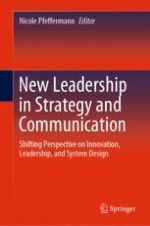2020 | OriginalPaper | Chapter
21. Facilitating Communication in Adaptive Planning Processes for Inclusive Innovation: Discussing an Integrative Approach
Authors : Bernardo Alayza, Domingo Gonzalez
Published in: New Leadership in Strategy and Communication
Publisher: Springer International Publishing
Activate our intelligent search to find suitable subject content or patents.
Select sections of text to find matching patents with Artificial Intelligence. powered by
Select sections of text to find additional relevant content using AI-assisted search. powered by
